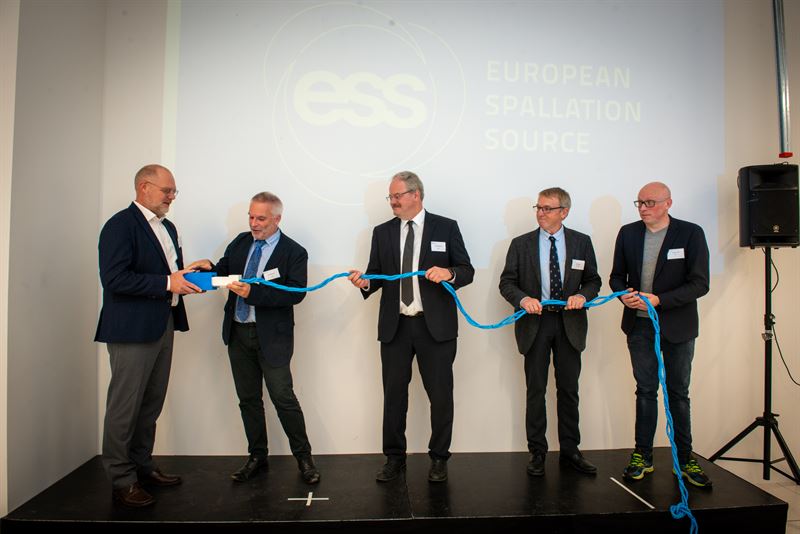ESS inaugurates data centre infrastructure in Copenhagen
Today, the research facility European Spallation Source (ESS) celebrated the official inauguration of its data centre in Copenhagen, a key part of the ESS Data Management and Software Centre (DMSC) that opened in 2016. Hans Müller Pedersen, Director General of the Danish Agency for Science and Higher Education inaugurated the installations with Kurt Nørgaard Clausen, Vice Chair of the ESS Council, and ESS Director General John Womersley. Among the attending guests were representatives from ESS’ Danish Partner Universities and Laboratories, such as DTU (Technical University of Denmark) and UCPH (University of Copenhagen), together with ESS staff.

Denmark and Sweden are the host countries for the international multi-disciplinary research facility ESS, which will be the world's leading research centre using neutrons and is currently under construction in Lund (Sweden). ESS will deliver cutting-edge materials science from 2023 and contribute to solving societal challenges within a wide range of areas, such as the environment, health, materials and energy. The DMSC, located in the COBIS (Copenhagen Bio-Science park) building in Copenhagen, will provide the analysis and modelling software that enables the researchers turn the experimental data produced at ESS into scientific results and innovation. The data centre, vital for storing and processing huge amounts of data, is now operational.
“As host country, Denmark plays an essential role for ESS and on behalf of all the 13 member countries I congratulate on this important milestone for ESS as a whole,“ said Kurt Nørgaard Clausen, Vice Chair of the ESS Council, who has been involved in the ESS project for many years. “On a personal note, as a former head of neutron scattering at the now closed research facility DR3 at Risø, it’s a great pleasure to see an important part of ESS on Danish soil.”
The DMSC staff currently consists of 32 employees, developing software and hardware for the control, analysis, and visualisation of the experiments at ESS, in collaboration with partners at universities and research laboratories all over Europe. When the experimental research program at ESS is fully running, the DMSC is expected to have 60-70 employees and will provide more than 3,000 annual researchers at ESS access to analyse and interact with data generated by their experiments.
“Denmark is proud to host ESS, and its Data Management and Software Center in Copenhagen, which will provide high-performance computing for the scientific community. Collaboration and synergies between ESS and the Danish research community will facilitate the integration of the DMSC into our research and innovation ecosystem,” said Hans Müller Pedersen, Director General of the Danish Agency for Science and Higher Education. “Hosting ESS will benefit Danish science and industry and enable Denmark to maintain its strong position within research fields such as magnetism and life science.”
When ESS is in full operation, the DMSC will handle and store large amounts of experimental scientific data, some 7-11 petabytes (PB) per year. The data centre in Copenhagen is designed to scale up and increase to up to 30 server racks, ensuring sufficient capacity. Making use of the indirect free cooling of the Scandinavian climate through an active rear-door heat exchanger technology, the data centre will only need active energy-intensive cooling when the outside temperature is above 17°C.
“The DMSC design focuses on reliability, scalability and efficiency,” said Jonathan Taylor, Head of the DMSC in Copenhagen. “We provide a resilient data centre infrastructure, which is crucial to ensure that the researchers using the instrument stations at ESS can carry out their experiments without interruption in their pursuit of scientific breakthroughs.”
In line with the FAIR data principles (Findable, Accessible, Interoperable and Reusable), ESS will make the experimental scientific data openly available, for the benefit of the whole scientific community.
The large amounts of experimental data generated at ESS in Lund will be transferred to Copenhagen through a >100 Gb/s fibre connection, provided by the Danish DeIC, Swedish SUNET and Nordic NORDUNET research networks.
More information:
Roger Eriksson, ESS Communications Officer, +46 721 79 23 11 roger.eriksson@esss.se
The multi-disciplinary research facility European Spallation Source (ESS), based on the world’s most powerful neutron source, will enable scientific breakthroughs within materials research, benefitting the development of better batteries, new medicines and more sustainable materials. ESS is a European facility hosted by Denmark and Sweden.
Tags:


